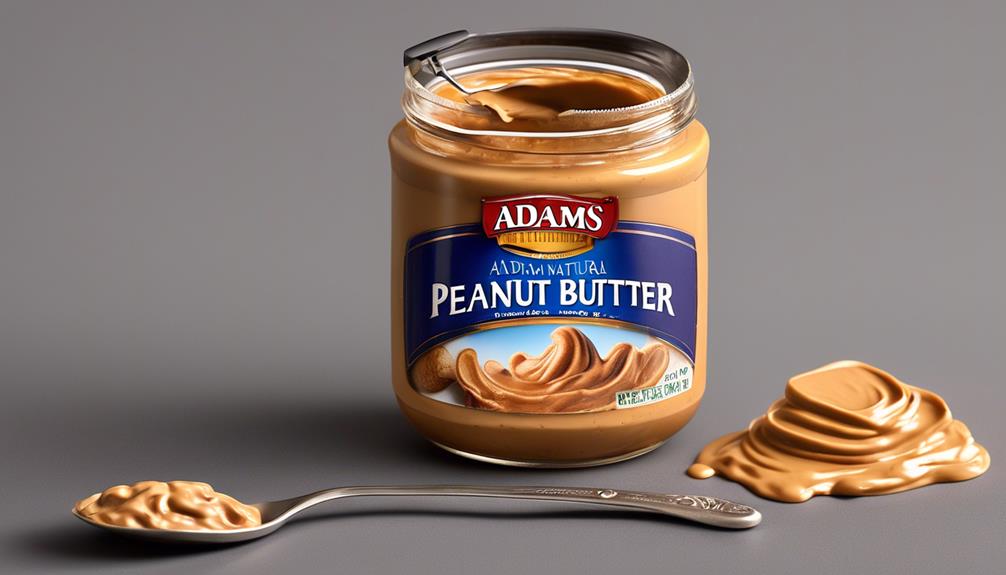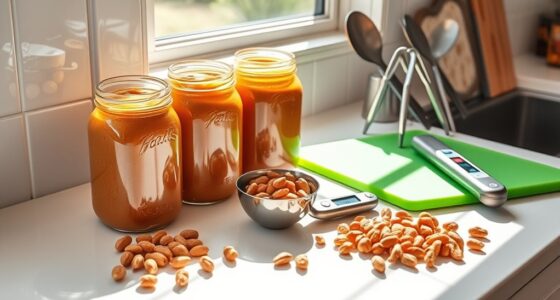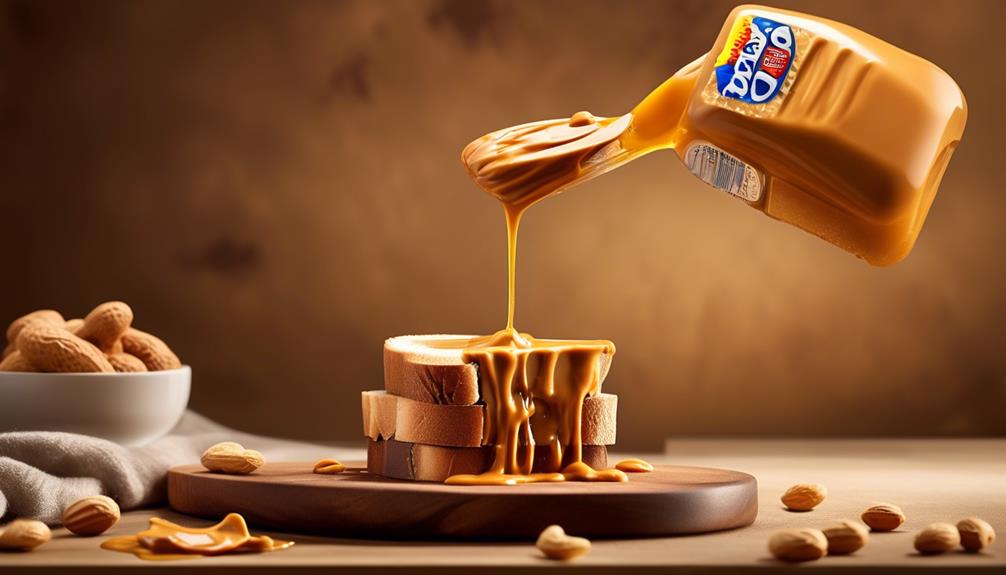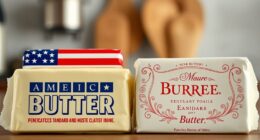Did you know that on average, each person in the United States consumes about three pounds of peanut butter per year? That’s quite a bit of peanut butter to measure out!
But what's the best way to do it? We've all struggled with sticky peanut butter clinging to our measuring cups, making it difficult to get an accurate measurement. But fear not, we have some tips and tricks to make measuring peanut butter a breeze.
So, what should you measure peanut butter with? Stay tuned to find out the most effective methods for getting the perfect portion of this beloved spread.
Key Takeaways
- Measuring cups, tablespoons, kitchen scales, and measuring spoons are common tools used to measure peanut butter accurately.
- Cookie scoop size is important for achieving even distribution and consistent results when measuring peanut butter.
- Adjustable measuring cups offer accurate measurements and versatility in measuring peanut butter.
- Eye measurement and fluid ounce measurement can be used as alternative measuring techniques, but weight measurement with a kitchen scale is the most precise and consistent method.
Measuring Cups
Using the appropriate measuring cup for the ingredient being measured ensures accurate results in cooking and baking. When it comes to measuring cups, versatility is key. These essential kitchen tools come in various sizes, typically including 1/4, 1/3, 1/2, and 1 cup, and are often made of plastic, metal, or glass. Their design with a level edge ensures precise measurement by scraping off excess ingredients, making them reliable for both liquid and dry ingredients.
Whether it's flour, sugar, milk, or oil, a measuring cup is indispensable for achieving the perfect balance of ingredients in your recipes. It's important to note that using the right measuring cup for the specific ingredient is crucial. For instance, a liquid measuring cup is designed to be filled to the brim and allows for accurate measurement at eye level, while dry measuring cups are meant to be leveled off with a straight edge.
Understanding the differences between the two types of measuring cups is vital for achieving consistent and accurate results in cooking and baking.
Tablespoons

When it comes to measuring peanut butter, understanding the equivalence of 1 tablespoon to 3 teaspoons is essential for precise portioning and accurate recipe outcomes.
Using tablespoons to measure peanut or almond butter provides a convenient and consistent way to portion out this sticky ingredient. A standard tablespoon is a unit of volume measurement, commonly used in cooking for both liquid and dry ingredients.
When measuring peanut butter, using a tablespoon can ensure accurate and consistent portions, especially when following recipes that require specific measurements. It's important to level off the ingredient when measuring with a tablespoon to ensure accuracy, as the texture of peanut butter can make it difficult to measure precisely.
Whether you're making a delicious peanut butter cookie or a savory peanut sauce, a tablespoon is a reliable tool for measuring this versatile ingredient.
Kitchen Scale

When it comes to measuring peanut butter, using a kitchen scale can be a game-changer. We can accurately measure the exact amount of peanut butter needed for a recipe, eliminating any guesswork.
This precision can make a significant difference in the outcome of our dishes.
Measuring Spoon
Consider using a kitchen scale as an alternative to measuring spoons for precise and consistent measurements of peanut butter. When measuring peanut butter, a kitchen scale can provide accuracy to the gram, ensuring that you use the exact amount required for your recipe.
To use a kitchen scale, simply place your bowl on the scale, reset it to zero, and then scoop out the desired amount of peanut butter until you reach the specified weight. This method eliminates the need for multiple measuring spoons and the mess that often comes with measuring sticky substances like peanut butter.
Additionally, it allows for easy adjustments if you need to add or subtract a bit of peanut butter. A light coating of cooking spray on the spoon can also help the peanut butter slide off easily, ensuring that you get an accurate measurement every time.
Measuring Cup
A measuring cup or kitchen scale provides precise measurements of peanut butter, ensuring accuracy in recipes.
When it comes to measuring peanut butter with a kitchen scale or measuring cup, here's what you need to know:
- Accuracy: Using a kitchen scale ensures precise measurements, crucial for recipes where the right amount of peanut butter is essential.
- Versatility: A kitchen scale can measure peanut butter in various units, offering flexibility for different recipes and promoting consistency.
- Convenience: Measuring cups with clear markings make it easy to measure peanut butter accurately, simplifying the cooking process.
- Personal Preference: Both options provide convenient ways to measure peanut butter, allowing you to choose the method that suits your cooking style and preferences best.
Digital Scale

When using a digital scale, accuracy of measurement is key in ensuring precise results.
The convenience and ease of operation make it a practical choice for measuring peanut butter and other ingredients.
With the tare function, zeroing out the weight of the container allows for the net weight of the peanut butter to be easily obtained.
Accuracy of Measurement
Using a digital scale for measuring peanut butter ensures precise and consistent results, as it provides accurate measurements and allows for easy adjustments to the desired weight. Here are the reasons why digital scales offer superior accuracy:
- Eliminates Guesswork: Digital scales provide exact measurements, eliminating the guesswork associated with using traditional measuring cups and spoons.
- Easy Adjustments: With a digital scale, it's easy to adjust the amount of peanut butter needed by simply adding or removing it until the desired weight is reached.
- Tare Function: The tare function allows you to zero out the weight of the container, ensuring that you measure only the peanut butter without accounting for the container's weight.
- Flexibility in Units: Digital scales offer the advantage of measuring ingredients in various units, providing flexibility and accuracy when working with different recipes and measurement systems.
Convenience and Ease
Moving from the discussion of accuracy in measurement with digital scales, we now shift our focus to the convenience and ease they provide in the kitchen.
Digital scales offer a hassle-free way to measure sticky ingredients like peanut butter without the mess. The ability to measure directly into a mixing bowl or container eliminates the need for multiple measuring tools, streamlining the cooking process.
Additionally, the tare function simplifies measurements by allowing easy subtraction of the container's weight. With the added benefit of unit conversion features, digital scales are versatile for various recipe requirements.
The clear digital display ensures that the weight of the ingredient is easily readable and trackable as it's added, making the entire measuring process straightforward and efficient.
Measuring Spoons

Measuring spoons provide precise and convenient measurements for various ingredients, ensuring accuracy in cooking and baking. Here are four compelling reasons why they're essential in every kitchen:
- Versatile Precision: Measuring spoons come in various sizes, such as 1 tablespoon, 1 teaspoon, 1/2 teaspoon, 1/4 teaspoon, and 1/8 teaspoon, providing the versatility to measure different quantities of ingredients accurately. This versatility ensures that even the smallest amounts of seasonings or flavorings can be precisely measured, enhancing the flavor profile of dishes.
- Accessible Design: With their long handles and narrow heads, measuring spoons can easily fit into spice jars and other small containers, making it effortless to scoop out ingredients with precision. This accessibility simplifies the often tedious process of measuring small quantities of various ingredients, streamlining the cooking and baking experience.
- Durability and Convenience: Measuring spoons are made from different materials, including stainless steel, plastic, and silicone, offering durability and easy cleaning. This ensures that they remain reliable kitchen tools, ready to assist in accurate measurements for countless recipes.
- Organization and Storage: Some measuring spoons come with a leveler for precise measurement, and others are designed to be connected by a ring for convenient storage. This organizational feature not only ensures precise measurements but also simplifies storage, keeping the kitchen tidy and efficient.
Measuring spoons are indispensable tools for any culinary enthusiast, offering not only precise measurements but also convenience, accessibility, and organization in the kitchen.
Cookie Scoop

When it comes to using a cookie scoop for measuring peanut butter, the size of the scoop is crucial.
Different scoop sizes allow for precise portioning and can help ensure even distribution of the peanut butter in your recipe.
This makes it easier to achieve consistent results and maintain the desired texture and flavor in your peanut butter-based creations.
Scoop Size
To accurately measure peanut butter and other sticky ingredients, utilizing a scoop size, also known as a cookie scoop, can provide convenience and consistency, eliminating the need for traditional measuring cups and spoons. The different sizes of scoop sizes cater to various portioning needs, making it easy to measure the precise amount of peanut butter for recipes.
Using a scoop size ensures accurate measurements and reduces the mess and hassle typically associated with measuring sticky ingredients like peanut butter. The ergonomic design and easy release mechanism of scoop sizes make them a practical and efficient tool for measuring peanut butter and other sticky ingredients.
- Say goodbye to messy measuring cups and spoons!
- Easily portion the perfect amount with various scoop sizes.
- Enjoy accurate measurements and hassle-free cooking.
- Embrace convenience and precision in your kitchen.
Even Distribution
For achieving an even distribution of sticky ingredients like peanut butter, consider using a cookie scoop in conjunction with cooking spray to ensure accurate measurements and easy release from the scoop. The table below illustrates the benefits of using cooking spray for achieving an even distribution of sticky ingredients:
| Benefits of Using Cooking Spray |
|---|
| Creates a non-stick barrier |
| Helps in achieving accurate measurements |
| Simplifies the cleanup process |
| Versatile for various kitchen tools |
| Enhances ease of measuring sticky ingredients |
Utilizing cooking spray not only aids in accurate measurements but also streamlines the cleanup process by reducing residue. Additionally, experimenting with different tools and techniques, such as warming the measuring cup slightly, can further enhance the ease of measuring sticky ingredients like peanut butter.
Adjustable Measuring Cup

An adjustable measuring cup is a practical and efficient tool for accurately measuring sticky ingredients like peanut butter, offering ease and convenience in the kitchen. Here are four reasons why an adjustable measuring cup is an essential tool for anyone who loves to cook and bake:
- Accurate Measurements: The adjustable design allows for precise measuring of sticky substances, ensuring that you get the perfect amount of peanut butter for your recipes without any guesswork.
- Minimized Mess: With the plunger mechanism, there's minimal residue left behind, making cleanup a breeze and keeping your kitchen tidy.
- Versatility: This tool isn't just limited to measuring peanut butter; it can be used for a wide range of ingredients, making it a versatile and practical addition to your kitchen.
- Efficiency: The adjustable measuring cup simplifies the process of measuring sticky ingredients, saving time and making cooking and baking more efficient.
Using an adjustable measuring cup takes the frustration out of measuring sticky substances, making it an invaluable tool for anyone who loves to cook and bake.
Eye Measurement

Eye measurement is a method of estimating ingredient quantities by visually gauging the amount needed without using traditional measuring tools, utilizing practical experience and familiarity with ingredient quantities. This technique relies on the cook's ability to estimate quantities based on their familiarity with the ingredients and their experience in cooking or baking.
When it comes to sticky ingredients like peanut butter, eye measurement can be particularly handy, allowing for a quick and convenient estimation without the need for precise tools. It does require practice and a keen eye for portion sizes, making it a valuable skill for seasoned cooks and bakers.
While eye measurement may not offer the same level of precision as using standard measuring cups and spoons, it can be an efficient and effective way to measure ingredients, especially in a pinch. Embracing eye measurement can add a practical and intuitive dimension to the cooking process, empowering individuals to rely on their senses and experience to achieve delicious results.
Fluid Ounce Measurement

Measuring peanut butter using fluid ounces provides a precise and consistent method for portioning in recipes, making it an efficient approach for incorporating this sticky ingredient into various dishes. Here are four reasons why fluid ounce measurement is beneficial:
- Consistency: Using fluid ounces ensures that you're adding the same amount of peanut butter each time, leading to consistent results in your recipes and dishes.
- Accuracy: Fluid ounce measurements allow for a more accurate representation of the amount of peanut butter being used, crucial for achieving the desired taste and texture.
- Efficiency: With fluid ounce measurements, there's no guesswork involved, saving time and effort while cooking or baking with peanut butter.
- Adaptability: Understanding fluid ounce measurements can help in adjusting recipes according to personal preferences or dietary requirements, allowing for flexibility in cooking and baking.
Weight Measurement

Moving from discussing fluid ounce measurement, we now shift our focus to the precision and practicality of weight measurement when incorporating ingredients like peanut butter into recipes. Weight measurement is crucial in achieving accuracy and consistency in cooking. Unlike volume measurement, which can be influenced by factors such as ingredient density and compaction, weight measurement provides a more precise representation of the amount of an ingredient being used. In the kitchen, a digital kitchen scale is an invaluable tool that enables accurate weight measurement in grams, ounces, or pounds. Understanding weight measurement not only ensures the correct balance of flavors and textures in recipes but also contributes to the desired outcome in cooking and baking.
| Pros of Weight Measurement | Cons of Weight Measurement |
|---|---|
| Offers precision and accuracy | Requires a kitchen scale |
| Accounts for ingredient density and compaction | May involve extra cleanup |
| Ensures consistency in recipes | Takes up additional space in the kitchen |
Incorporating weight measurement into your cooking routine can elevate your culinary skills and provide a more reliable way to measure ingredients like peanut butter.
Peanut Butter Pump

The Peanut Butter Pump offers a convenient and mess-free solution for measuring peanut butter with precision and ease. Here's why we love it:
- Mess-free: No more sticky fingers or messy countertops. The pump dispenses the perfect amount of peanut butter without the hassle of cleaning up afterwards.
- Easy to use: It's as simple as pressing a pump to get the precise measurement you need. This makes it a great tool for anyone, regardless of their cooking or baking expertise.
- Accurate measurements: Say goodbye to guesswork. The Peanut Butter Pump ensures that you're always using the right amount of peanut butter in your recipes, leading to consistent and delicious results every time.
- Time-saving: With the pump, measuring peanut butter becomes a quick and effortless task. It's a handy gadget for anyone who loves to cook or bake with peanut butter, saving valuable time in the kitchen.
The Peanut Butter Pump is a game-changer for those who enjoy the creamy goodness of peanut butter in their culinary creations.
Portion Control Scoop

When it comes to accurately portioning sticky ingredients like peanut butter, the Portion Control Scoop offers a practical and efficient solution. This tool provides precise measurements without the mess or waste often associated with sticky substances. Its design ensures an exact portion is easily scooped and released, making it a convenient and valuable addition to any kitchen.
The non-stick surface and efficient release mechanism make it ideal for substances like peanut butter, eliminating residue and ensuring accurate portions. Moreover, the Portion Control Scoop is versatile, suitable for measuring various ingredients such as peanut butter, tahini, almond butter, and more. This versatility makes it an essential tool for anyone who enjoys cooking or baking.
Silicone Spatula
Our experience in the kitchen has shown that a silicone spatula is a versatile and indispensable tool for handling a wide range of cooking and baking tasks. Here are four reasons why we believe a silicone spatula is a must-have in any kitchen:
- Versatility: Silicone spatulas can be used for mixing, scraping, and spreading various ingredients, making them incredibly versatile for a wide range of recipes.
- Heat-Resistant: These spatulas can withstand high temperatures, making them suitable for cooking and baking without the risk of melting or warping.
- Efficient Ingredient Handling: The flexible and non-stick nature of silicone spatulas makes it easy to scrape every last bit of batter or dough from bowls and containers, reducing waste and ensuring thorough mixing.
- Precision and Hygiene: Silicone spatulas come in different shapes and sizes, allowing for precise and efficient handling of different cooking tasks. Additionally, their non-porous and hygienic properties make them easy to clean and maintain, promoting food safety in the kitchen.
Having a silicone spatula in your kitchen arsenal not only enhances your cooking experience but also ensures efficient and thorough handling of ingredients.
Frequently Asked Questions
What Is the Best Tool to Measure Peanut Butter?
We've found that an adjustable measuring cup is the best tool for measuring peanut butter. Its versatility and easy release make it a practical choice.
We also recommend using a non-stick coating to ease the process. Additionally, warming the measuring cup slightly can help with smoother release.
Experiment with different techniques, such as using a spatula or digital kitchen scale, to find what works best for you.
Do You Use a Dry or Liquid Measuring Cup for Peanut Butter?
We typically use a dry measuring cup for peanut butter. It can be messy and challenging to measure accurately due to its sticky nature.
To make this task easier, we sometimes spray the measuring cup with cooking spray or oil to create a non-stick barrier. Using a flexible silicone measuring cup, warming the measuring cup, or using a spatula can also help release the peanut butter more easily.
Experimenting with different methods, such as using a digital kitchen scale, can also be helpful.
How Do You Measure Peanut Butter Without a Tablespoon?
We measure peanut butter without a tablespoon by using cooking spray to coat the measuring cup or spoon, creating a non-stick barrier for easier measurement.
Other methods include using an adjustable measuring cup, warming the measuring cup, or using a spatula to push the peanut butter out.
Experimenting with these techniques can help find the most convenient way to measure peanut butter with less mess, making baking a more enjoyable experience.
Is Peanut Butter Measured by Weight or Volume?
Wondering about measuring peanut butter? Peanut butter is typically measured by volume rather than weight. Using a measuring cup is standard practice. To make it easier to release, coat the measuring cup with cooking spray or oil.
Experiment with different methods, such as using a digital kitchen scale, to find the most convenient way for you. It's all about finding what works best for your cooking routine.
Conclusion
In conclusion, when it comes to measuring peanut butter, using the right tools can make all the difference. Whether it's measuring cups, spoons, or a kitchen scale, finding the method that works best for you is key.
And don't forget the helpful tip of using a non-stick coating to make the process easier. By taking the time to measure accurately, you can ensure that your recipes turn out just right every time.









